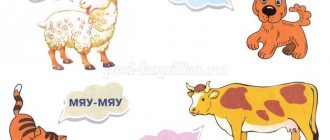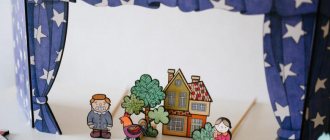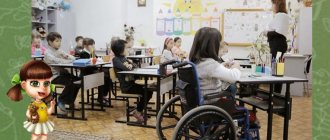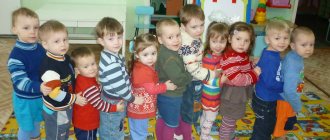Good day everyone! Today I want to talk about a very serious topic, like speech therapy classes with children aged 5-7 years. After all, many people attribute incorrect sound pronunciation to age. It will outgrow, we think. But things may turn out differently. Do you know about the troubles that lead to clumsy speech in an adult?
First of all, this is a huge lack of confidence in oneself and one’s strengths. Just imagine! Such a complex will create problems anywhere! From finding a good job to success in your personal life. Let's correct the children's incorrect pronunciation before it's too late! We will study a number of interesting games and activities on the most common situations. Let's get started!
Types of defects
I propose to begin by considering the types of speech disorders. There are many of them, but each child has his own.
- Stuttering. This is a fairly common phenomenon. You can notice it around the age of 3, at which time the first sentences begin to form. It is important to immediately contact a good speech therapist. After all, no specialist can guarantee that in a couple of years the problem will not return again...
- Dislalia. The word is very clever! But behind this lies another common problem for preschool children - incorrect pronunciation of consonant sounds. This is especially true for “R”, “L” and “W”.
- Nasality. Here, of course, the main role is played by the natural factor - the incorrect structure of the speech apparatus. And it would be very good to visit an otolaryngologist to solve this problem.
- General speech underdevelopment (GSD). Here, dear readers, close relatives of the baby are often the culprits. Various kinds of baby talk and insufficient communication lead to the child constantly confusing everything. I'm talking about endings in words, confusing prepositions, etc. This can have a bad effect later. After all, school is coming soon!
- Congenital pathologies of a neurological nature. Complex treatment from a neurologist is already required.
- With delayed speech development (SDD). This usually manifests itself around the age of 3. After all, at this time children babble non-stop! Therefore, if you have a short vocabulary, contact a specialist without delay!
Pay proper attention to your little one. Monitor your child's speech. And in case of gaps, seek help from a doctor!
Typical speech disorders in children 5-6 years old
Most older preschoolers have difficulties with:
- mastering sonorous and hissing sounds;
- sound analysis of words;
- development of narrative speech;
- writing a story and descriptions.
Of course, such problems can be minor, only slightly different from the age norm, or serious, up to and including general speech underdevelopment (GSD). It is necessary to contact a speech therapist in any case, but the supportive work of parents at home is also very important.
It is worth noting that regular speech therapy exercises and classes for children 5-6 years old are useful for every child at home, because they help to master literacy faster.
When should I take my child to a speech therapist?
I don’t even know why, but today the number of children with problems with sound pronunciation has increased sharply. Tell me, how much time a day do you devote to reading, and how much to watching TV together? One of the reasons I see is the global interest of children (almost from the cradle) in technical means. The children communicate little. There is no desire for this. What for? After all, there are so many interesting things around, and they are concentrated in one place: on TV.
As a result, we ourselves may miss that golden moment to send our child to a specialist. Speech therapists have an unspoken rule: the sooner, the better. That's right, this should be resolved immediately. Sorry for the comparison, but if you stain a dress and leave it for a long time without washing, what will happen? Of course, there is a risk that the stain will set in and not wash off. So it is here.
Speech therapy classes for children - we do them at home.
The peak of visits occurs for children 4 - 5 years old. Right now they must pronounce complex consonants and construct sentences with logic. More precisely, even texts involving elementary words. There must be consistency in his stories. Do a test by asking your child to retell a simple picture. Did not work out? Then see a specialist!
When an accurate diagnosis is made, you will begin to attend classes that are sure to give results. But don’t be lazy at home either, practice in a playful way, at least for 20 minutes. Just don’t force it, kids don’t like it! And I’ll tell you what exercises you can do at home, depending on the problem.
For pronunciation of sounds
Those who have already encountered this side of the coin know that the most insidious sounds are R, L and Sh. If the child simply does not pronounce them (losing them in the word), the time has not come yet. And when he begins to pronounce other, simpler letters instead of them, it’s a reason to think.
Here are a few exercises for you to take note of. They are of an articulatory nature, for the correct formation of the uvula, palate, and lips. In general, the entire articulatory apparatus.
Let's learn to say R clearly! I really like these events:
- Open your mouth wide and smile. The lower jaw is motionless, and the tip of the tongue is raised up, as if stroking the palate back and forth. Recommendation: do it yourself first so you understand the principle. This way, it will be easier to convey the essence to the child!
- We brush our teeth with the tip of our tongue from the inside. The mouth is wide open. See how simple it is! A five-year-old child can do it without difficulty.
- And another interesting option. Place a small ball on a wooden stick, the child opens his mouth and says DDRRR. At this time, you move this tool under your tongue. Movements must be made quickly.
- Ask to say “YES”, while letting the tongue rest against the teeth. “YES” - in the upper palate.
Watching this video will help you pronounce the sound “R”.
Learning to pronounce L:
- Open your mouth wide, place your tongue on your lower lip, holding your chin, pronounce La, Lo, Li, Lu.
- Run your tongue across the roof of your mouth as if we were painting it.
- And let him try to touch the tip of his nose with his tongue.
- We lick the imaginary jam from our lips.
Now the problematic letter Ш:
- Insert the tip of your tongue under your upper lip and tear it off sharply with a click.
- The lips should be rounded, pulling them forward. Hold this for 6 seconds.
- Take a piece of cotton wool and place it on your baby's nose. And let him try to blow it away so that it flies upward. This is a fun exercise that your child will definitely appreciate.
Here is a selection for every day, for clear speech pronunciation.
Types of speech therapy classes for children
Speech development classes may consist of:
- finger games;
- articulatory gymnastics;
- games for onomatopoeia, hearing development, logorhythmics (poetry with movements);
- poems for replenishing vocabulary, speech development.
Speech therapy classes should be conducted daily. The most difficult thing about them is to be able to interest the child. Therefore, it is not at all necessary that such classes be conducted like lessons at school, where students humbly sit at their desks and the teacher explains a new topic in a monotone voice. For kids, such activities are akin to torture. Turn on your imagination: let your baby learn with you, playing on the rug, sitting on a pillow, hiding in his hut, jumping or running... The main thing is the final result. Build your lessons in a playful way - this way your child will remember the material better and won’t get tired at all.
In addition, when arranging speech therapy classes with your child at home, you should:
- Start classes with 2-3 minutes, gradually increasing their duration to 15-20 minutes.
- Make classes interesting so that the child has a desire to study. Never force your child to do exercises - you will get the opposite result.
- Perform tasks more often, but let them be short-term.
- Treat your child’s failures easily, without shouting, with understanding. Analyze each situation together, for example, look for the reason why the child has such a naughty tongue, and how to fix it.
Now let's look at each of the types of speech therapy games listed above.
Finger games
Through finger games, a child's fine motor skills develop. How does this help speech development? Scientists have found that there is a close relationship between the human hand and the part of the brain that is responsible for speech. Therefore, by learning texts using finger exercises, the child develops spatial thinking, imagination, reaction speed, attention and emotional expressiveness. Memorizing texts occurs faster, and speech becomes more expressive.
The effectiveness of finger games is achieved if you work with your child daily, devoting only 5 minutes to such exercises. Let's look at a few examples of finger games.
- "Flower". Fingers pointing up, gathered together. We make a bud from half-bent palms, pressing them together. We begin to pronounce the quatrain, performing movements on every second line:
The sun is rising -The bud is blooming! (spread the fingers of both hands to the sides, keeping the lower part of the palms together)
The sun is setting -
The flower goes to bed! (return to the starting position).
- "Kitty." Place your palms on the table and clench them into fists. To the words “Fist - palm. “I’m walking like a cat,” we simultaneously straighten our fingers, without lifting the handles from the surface of the table, and squeeze them. To complicate the exercise, unclench your palms alternately on the count of “one, two.” You need to repeat the exercise 3-5 times.
- "The bird is flying." Cross your arms with your palms in front of you. Interlace your thumbs together to imitate the head of a bird. The remaining fingers are wings that will need to be flapped without separating the fingers.
The birds have flown (flapping their wings)We sat down and sat, (press our palms to our chests)
Then we flew.
- "Maple". This game is suitable for children 3 years of age. All movements are performed in accordance with the text of the poem:
The wind quietly shakes the maple tree, (spread your fingers and pull them up)Tilts to the right, to the left: (swing your palms to the right and left)
One – tilt and two – tilt, (tilt your palms as low as possible in the indicated directions)
The maple leaves rustled. (we move our fingers quickly)
- "Cake". We perform movements according to the text of a poetic work.
We remember the dough with our hands (squeeze and unclench your fingers several times)We will bake a sweet cake. (think imaginary dough)
Lubricate the middle with jam (make circular movements with your palms on the table surface)
And the top with delicious cream (with three palms touching each other in a circular motion)
And coconut crumbs
We will decorate the cake a little (we imitate the action with both hands)
And then we’ll make tea -
Invite a friend to visit! (we shake our left hand with our right hand).
- "Winter". Suitable for children 4-7 years old.
One, two, three, four, five, (fingers bend one at a time)We went out into the yard for a walk.
We sculpted a snow grandmother (we perform the movement of sculpting snowballs)
The birds were fed grains (we throw grains, rubbing our fingers together)
After we rode down the hill, (we run the palm of our right hand over our left palm)
They were happily lying around in the snow. (we alternately place the pens on the table surface, either with our palms or with our backs)
We came home in the snow, (shake off the snow from our palms)
We ate borscht and went to bed. (we make movements with a spoon and pretend to be asleep by folding our hands, palms to palms, and placing them under our cheeks)
Finger games can be used as physical education during speech therapy classes. They help to change the type of activity without losing children's attention and desire to learn. In addition, it is interesting, fun and useful. The main thing is to tell the poems with exciting expression and clearly show the movements.
In addition, finger games help:
- develop coordination of movements of both arms of the child;
- combine the child’s speech and physical activities, use them simultaneously;
- develop precise and differentiated movements of children’s fingers and hands;
- learn to repeat the movements of adults;
- become more attentive, develop visual perception;
- improve memory, imagination, perseverance.
Finger games need to be done systematically. Classes are possible with one child or with a group of children. However, it is important to take into account the age of the children, their mood, readiness for classes, desire and opportunity.
Articulation gymnastics
You can find the presentation and musical accompaniment for articulatory gymnastics on this page.
Articulatory gymnastics is necessary for correct sound pronunciation, strengthening the muscles of the face, tongue, lips, and soft palate. There are many exercises, a specialist will help you choose the most suitable ones for your sounds.
Tasks are divided into static and dynamic. Each has a name that your baby can easily remember, which will make it much easier to understand the instructions during class. Using a little imagination, you can go on fabulous trips with your child, where the main character will be the child’s tongue. There are many variations, it all depends on you. Below are the same exercises; after reading the descriptions, you will understand that they are not complicated and do not require additional knowledge from you (parents).
Articulatory gymnastics is a group of exercises for the tongue and lips. They are the main ones in the process of sound pronunciation. If the tongue is not developed enough, a person will not be able to pronounce sounds, which means that his speech will be incomprehensible or not clear enough.
They perform articulatory gymnastics in front of a mirror - this way you can see the correct movements of the tongue and lips during exercise. It is very important for children to see how his tongue and lips move, how and where they are located. This way, understanding of their correct location quickly comes, on which the effectiveness of articulatory gymnastics depends. Speech therapists recommend doing the exercises twice a day for 5-7 minutes. As a result, your child will receive correct and clear speech.
Let's look at a few simple but effective exercises.
- "Smile." Stretch your lips strongly in a smile, but your teeth should not be visible. Hold a smile for 30 seconds.
- "Fence". Smile hard so that your teeth are visible, hold the smile.
- “Let’s punish the naughty tongue.” Open your mouth slightly, place your tongue on your lower lip and, slapping it with your lips, pronounce “five-five-five...”.
- "Tube". Open your mouth, stick out your tongue and try to bend its side edges upward in the form of a tube, hold it in this position for 30 seconds.
- “Let’s lick the jam.” Slowly, without lifting the tongue, first lick the upper lip from corner to corner, then repeat the procedure with the lower lip.
- “The clock is tick-tock.” Make a smile, open your mouth slightly, then use the tip of your tongue to touch the corners of your mouth one by one.
- “Brushing our teeth.” Smile, open your mouth slightly, then with the tip of your tongue, pressing it hard enough, brush the inside of the teeth of the lower row (7-10 times). Repeat the same exercise with the teeth of the upper row (7-10 times).
- "Swing". Smile and open your mouth wide. Then lower the tip of the tongue behind the bottom row of teeth by “one”, and lift it by the top row by “two”. Repeat – 4-5 times.
- "Snake". Open your mouth, stick out the narrow part of your tongue from your mouth and quickly hide it back. Touching teeth and lips is prohibited.
- "Rent a pencil." Place a pencil on the table in front of the child. Ask him to smile, place the wide front part of the tongue on the lower lip and, slowly (exhaling air), blow on the pencil so that it rolls along the surface.
In addition to articulatory gymnastics, exercises are used aimed at developing the voice, breathing, and speech hearing. In this complex, classes will allow the child to develop correct sound pronunciation.
Logorhythmics, hearing development and onomatopoeia
Phonemic hearing (also called speech hearing) is the ability to distinguish, understand and produce sounds. With insufficient development of speech hearing, the perception of what is heard is distorted, and accordingly, speech is produced incorrectly and unclearly. To correct or prevent the development of this problem, the following exercises are performed with children:
- “Listen Ears” is a game for developing hearing. The goal is to improve auditory attention and strengthen the ability to distinguish sounds. The adult shows the child several different objects that can make sounds - spoons, drums, glasses, rattles, maracas, etc. Together with your baby, you need to listen to how objects sound. Then the adult asks the child to turn away and guess what object will sound behind him.
- “Where is it ringing?” - an exercise to develop hearing. To play you will need a bell and a spacious room. The child stands with his eyes closed, while the adult quietly moves around the room, ringing the bell in different places. The child’s task is to point with his hand where the bell rang without turning around.
- Onomatopoeia games: in principle, any children’s story-based picture is suitable for this exercise. For example, in the picture a girl is rocking a doll: “Oksana puts the doll Masha to sleep and says ah-ah. Let's help her together! A-a-a!” Help your child, use movements that imitate rocking a baby, control your baby's articulation.
- Exercises to imitate the voices of birds and animals. To make such games more interesting, it is recommended to use pictures or figures of animals and their babies as visual material. For example, the game "Komarik". For this you will need an image of a mosquito. The adult says: “Meet this mosquito’s name Stepan. When he flies, he likes to sing the song z-z-z. Can you sing this song? Let's try it together with Stepan! Z-z-z.” Then we invite the child to catch the “mosquito” in his fist and listen to his song. We grab the air with our fist, bring it to our ear and pronounce: z-z-z. Next, we invite the child to also catch the “mosquito” and listen to its song. You can imitate everyday noises: scissors cutting - chick-chick, water dripping - drip-drip, etc.
- Logorhythmics are speech therapy exercises that combine movements, speech and music. Children really like this type of activity - they find it fun and interesting. First, the adult reads the poem and shows the movements, all of which is accompanied by skillfully selected music. Then the children repeat everything themselves or with an adult - it couldn’t be simpler. The main thing is to prepare thoroughly in advance. For example, the game "Walk".
Along a narrow path (we walk in place)Our legs walked (we walk, raising our legs high)
Over the pebbles, over the pebbles (we slowly shift from foot to foot)
And into the hole... bang! (jump and sit on the floor)
Poems for replenishing vocabulary, speech development
You can download poems and exercises for them here.
Tongue twisters are great for speech development - these are small rhyming phrases. With their help, speech becomes clear and correctly correct, they increase the child’s vocabulary, improve speech hearing, and improve diction.
- The beavers go into the cheese forests,
Beavers are kind, beavers are kind.
- Dali along with curdled milk
Our Klasha porridge.
Ate-ate porridge Klasha
Along with curdled milk.
- Six little mice rustle in the reeds.
- Sasha knocked off the cones with his hat,
I got a bruise on my forehead.
- Mama washed Mila with soap,
Mila didn't like soap.
There are many such tongue twisters; you can find them in specialized literature for children. You shouldn’t immediately learn complex poems with your child - start small. And remember: the child knows and understands much more words than he pronounces; they are simply, so to speak, “in sleep mode.” And for the baby to start using these words in communication, you need to help him. And this can be done by constantly studying with him, reading books to the child, looking at pictures with him, commenting on what he saw or heard. Help your child become an erudite person with beautiful diction and competent speech. And then a successful and happy life will be guaranteed to him.
Comments ()
Learning to speak clearly
At 5 - 7 years old, a child is already able to repeat many exercises after a parent or teacher. But among them there are also complex ones. I tried to put together the simplest and most effective ones. By the way, they are also perfect for children with special needs.
Articulation gymnastics
- Smile so that your teeth are visible. And then we pull the sponges into a tube.
- Tighten your lips as hard as possible. Gently relax.
- Bite your upper and lower lips alternately with your teeth.
- Clattering of hooves. This is a well-known action. The kids will love it without a doubt!
15 minutes is enough time. By the way, such corrective manipulations are perfect not only for children, but also for any people with problems with sound pronunciation.
OLYMPUS DIGITAL CAMERA
Here are a few more examples of correcting the development of speech formation:
- Everyone knows how babies cry? So let's play this sound: Wah, Wah.
- Let's squeak like little mice: Pi, Pi.
- How loud do we make when we get lost in the forest? Ay, ay!
- A strong wind howled: UUUU.
- And now a combination of vowels and consonants. Imitation of animal calls: Meow, Mu, Kwa, Ko-Ko, Ga-Ga.
- The bear growls: RRR.
- We sing in a little voice: La-la, la-la-la.
Singing, by the way, is very useful. Choose a song that your child likes. Perhaps timed to coincide with the nearest holiday. They also like “Two cheerful geese lived with grandma,” “There was a birch tree in the field.” At first glance, they are simple, but the words flow smoothly, which is very important for corrective work. By the way, kindergarten teachers use this. There are definitely music lessons there. But developmental activities with a speech therapist are also present there.
Find out a list of books and albums on speech development.
Final chords
We learn to speak clearly, competently and beautifully, first of all, for ourselves. The desire not to stand still, to develop, to set goals, to go towards them - all this gives us energy and makes us strong. And if we try to make our thoughts and feelings beautiful, then we will succeed. After all, thoughts are born from feelings, thoughts are clothed in words, and words are the components of our speech.
We will share our creative energy with children to help them overcome the problems that arise. How else?
Kindergarten classes
Tell me, does your child attend kindergarten? If so, how are speech therapy classes conducted there? In the garden where our Dominic goes, there are 2 types:
- Individual. When a child has a certain problem.
- Group (frontal). A group of children with similar defects gathers.
Ideally, this should be the case in all preschool institutions. But 5 - 7 years old, this is already a preparatory group. After all, school is coming soon! What activities are good here? One of these is chants. And these are not simple songs, as you might think. This is singing and performing certain actions simultaneously.
Here is the simplest option: “the plane is flying.” Children sing to the melody of UUUUU, arms should be spread like wings. The teacher guides their actions:
- We hum at different volumes (the plane flies further, then flies closer).
- Broken. When making the sound UUUU, the children hit themselves in the chest with the palm of their hand.
- We're landing. Performing UUUU, spreading their wings, the children each run to their own chair.
The manipulations with the microphone are very interesting. The kids hear their voice, and at the same time they either move the microphone away or bring it closer to themselves.
There are, of course, a lot of troubles. But now, most of them are solvable. Even those called ZPR or ZPRR.
A diagnosis of mental retardation is not a death sentence
There are parents who imagine and invent defects for their child. It’s not for nothing that people say: “It’s better to be safe than sorry.” But there are those who point blank see nothing wrong. But by the age of 5, a child should already be able to express his thoughts in understandable phrases. Do not confuse syllables in words.
There are several diagnoses that baffle parents.
- ZRR. When only the word pronunciation is underdeveloped, but mentally the child is fine. It’s good if it is detected before 4–5 years of age, since then another stage begins: zprr.
- ZPRR delayed psycho-speech development. When the child’s psyche and mental abilities are also involved in the process.
- ZPR is just mental development. The speech apparatus also suffers, but the basis here is the baby’s psyche.
I will not talk about the reasons that prompt such states. But, if this happened, then the rule of speech therapists (and all other doctors!) is observed here. And it says: “The sooner the better.” I hope you understand that, as with any disease, there are more complex forms.
Be sure to find a good specialist who will find a common language with the baby. Most likely, a neurologist should also be involved here. But first of all, maintain a good emotional background at home. Believe me, a lot depends on this. Well, now I’ll write recommendations for exercises with mental retardation.
Literature
If there are any defects in sound pronunciation, you need to have the right books at home. They are compiled by competent authors. And in combination with visits to speech therapy lessons, they will definitely help you cope!
- “Speech therapy homework for children 5-7 years old with OHP” Teremkova N.E. This is album No. 1, there are 4 of them in total. And each is dedicated to certain lexical topics.
- “Speech therapy group: play sessions with children aged 5-7 years” Derbina A.I. The best way to get your child interested in learning is to play with him. This manual is built in a playful form. And it is intended for children with complex defects.
- “Speech therapist lessons. Games for speech development” Kosinova E.M. As you can see, everything here is also built on game elements. What I liked is that the benefit is suitable for 6 months to 6 years! And here you can find both finger games and material on articulatory gymnastics.
- “Encrypted tongue twisters. Sweetie" Kodolbenko E.A. Do you remember from childhood: “Sasha walked along the highway and sucked on a dryer”? Here is a very similar guide, with funny sayings that will appeal to the little reader.
- “Fun Logorhythmics” by E. Zheleznova. This is an audio tutorial. Anything can be invented to interest a child! But the main thing is that it really is beneficial! Funny poems for the development of speech and attention, exercises for gross motor skills and rhythm.
You may be interested in reading books for children from 5 to 8 years old: a list of the 40 most interesting books by year.
I hope these manuals will become your real helpers for homework with little fidgets. Tell us, what measures to eliminate speech defects do you know? How do you work out? What are you reading for this? Share your experience by leaving comments. And subscribe to blog updates! See you soon. Bye!
Individual correctional classes for preschoolers
For various reasons, the process of developing full pronunciation slows down for many children. Pronunciation defects will not be eliminated on their own; to eliminate them, you need systematic exercises with a specialist, as well as joint individual lessons at home.
A well-designed training system will definitely help. Individual speech therapy classes are conducted only after consultation and examination.
Speech therapy in the form of a game
General tips for practicing at home
After a detailed diagnosis of the speech of a preschool educational institution student, it is necessary to carry out correction and begin to engage in speech therapy tasks for children. Class time should not be more than 20 minutes. According to the theory of speech therapy, if you study more than you should, the material will not be fully absorbed.
In addition, speech therapists advise practicing while playing, since play is the main activity in the preschool period.
Note! Any speech therapy classes for correcting the pronunciation of sounds are built in the form of a game.
How to build a lesson
The child will learn the material better and will not get tired at all if the tasks are in the form of a game. In addition, when working with a kindergarten student at home, it is important to structure the process correctly:
- You need to start the exercises with 3 minutes, carefully increasing the exercise time to 20 minutes.
- Organize lessons correctly so that the child has a sincere desire to study.
- It is forbidden to force you to exercise - there will be no positive results from such exercises.
- You need to exercise often, but not for long.
- Do not criticize the child for failures (an important condition), do not shout, and treat with understanding.
How to teach a child to speak the sound [r] without a speech therapist at home
We need to analyze any situation, find the reason why it doesn’t work out, and try to solve it together. There are many types of speech therapy exercises. For example, the online editorial office of Shakhovskaya and Volkova offers activities and games.





